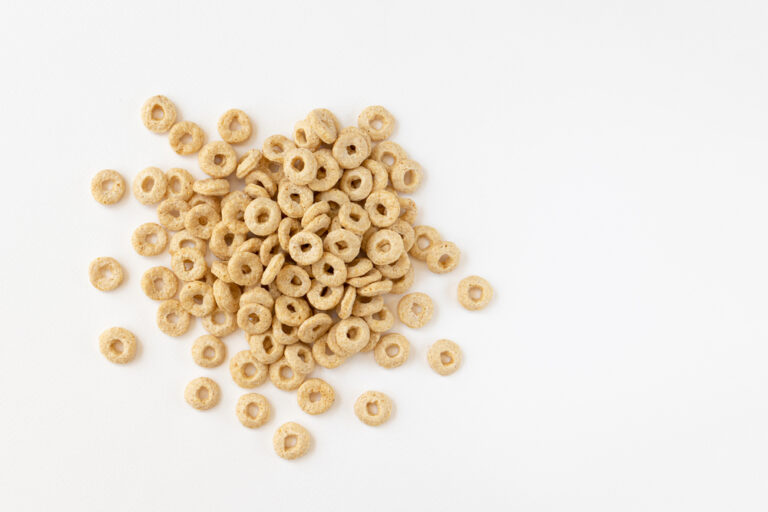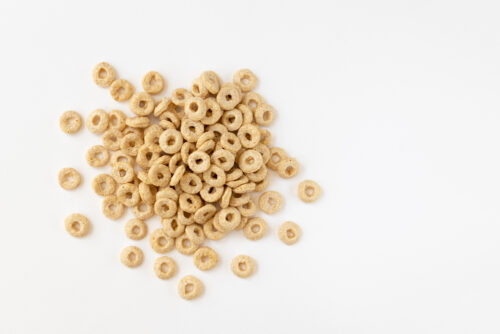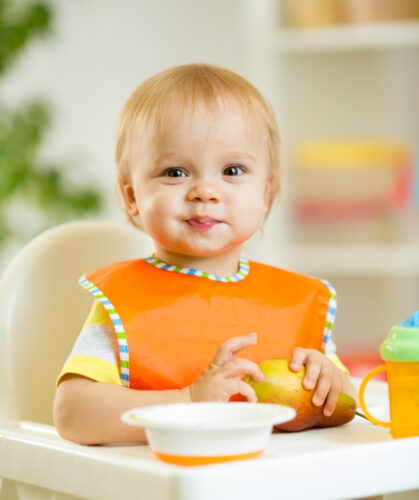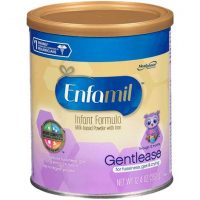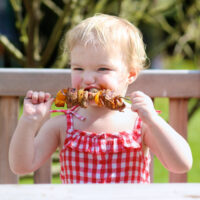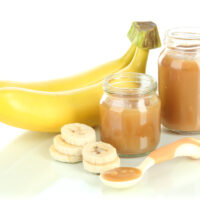While offering fruits and vegetables first is recommended once baby starts eating solids, you likely have thought about giving them some finger foods to snack on. One of those foods is the always classic and delicious Cheerios.
But when is a baby ready to eat Cheerios?
It’s recommended to wait until your baby is about nine months old before you offer Cheerios for the first time. At this point, they have grasped the art of chewing and are sitting up on their own.
Don’t let their lack of teeth fool you. Cheerios are great even for those gummy babies. The puffed-up cereal dissolves quickly, so you don’t have to worry about any choking dangers.
Signs Your Baby is Ready for Cheerios
Baby Can Hold His or Her Head Up
If you still have a bit of a bobblehead on your hands, they are not ready for Cheerios. You want to ensure your baby is doing a stellar job at holding their head up before offering them the cereal snack. Once your baby has developed strong neck muscles, they will have an easier time eating. In addition, it will aid in swallowing and helps your baby ingest their food correctly.
Baby Can Sit Up Unassisted
If you are still relying on a bouncy seat or Bumbo for your child to sit up, they are not ready to try Cheerios yet. Your baby should be able to sit for long periods without assistance and no longer slowly fall to their side when they are losing their balance.
At nine months, your baby is probably doing very well at sitting up, so there shouldn’t be an issue. However, all babies develop at different paces, so it’s essential to follow their lead. If they don’t seem ready to snack on Cheerios, then you may want to wait an extra month or so.
In addition, if your baby is on the move and crawling around, they likely also have the coordination needed to sit and eat properly. All that moving around will make them hungry for a delicious snack, too!
Baby is Using a Pincher Grasp
Cheerios are small pieces of cereal, so your baby should be able to use their pincher grasp to pick up each piece. If your little one uses their thumb and index finger to pick up small objects, they are likely ready for their first Cheerios snack.
A baby is ready to eat Cheerios when they can feed it to themselves without your assistance.
Baby Is Chewing Food
While Cheerios do dissolve fairly easily, your baby will have to do some chewing first. In addition, while some gagging is normal, if your baby continually gags on food, you should reconsider what you are offering them.
Remember, a baby doesn’t need teeth to be able to eat correctly. Babies do an excellent job of mashing food up with their gums.
They No Longer Have Their Extrusion Reflex
If you think back to the first time you offered your baby a puree, they likely pushed the food out with their tongue. That’s called their extrusion reflex. Once the reflex stops, babies start to get used to the eating process. As for Cheerios, not having the extrusion reflex means your baby will gladly pick up the cereal and put it in their mouths.
Your Baby is Interested in Foods
Finally, you’ll want to look for signs your little one is interested in eating. You likely will notice them watching you eat and also mimic the eating motions. This is a surefire sign that your babe is interested in eating. I remember eating in front of my son and looking up to find him staring right at me, copying the chewing motions.
Why Cheerios Shouldn’t Be Baby’s First Food
You likely know the first foods you offer your little one should be vegetables and fruits. However, there are other reasons why you should hold off giving Cheerios after your baby has started eating solid foods.
You want to make sure they are getting the hang of the eating process. Chewing is a whole new ball game for babies, and you want to ensure they are ready to move on from purees before they try Cheerios.
While they do get mushy after some time in your baby’s mouth, they don’t dissolve as quickly as Puffs. It’s recommended you still wait a little bit to offer Puffs, but you will notice your baby has an easier time eating them versus Cheerios.
Finally, while Cheerios do have a lot of the good stuff, they are still processed food, and it’s best to limit the amount you give your little one. We have a thorough list of the best first foods to offer your baby to help you get started.
How to Serve Cheerios to Babies
The easiest way to serve Cheerios to babies is to lay a few on the snack tray of their high chair. As your baby gets older, you can offer Cheerios in a bowl of milk. Remember, babies under one year of age should not be given cow’s milk. While you likely don’t want to waste any liquid gold, even just putting a little breastmilk in a bowl with cereal will help them get used to eating with a spoon.
While it takes time for babies to get used to eating with a spoon, it’s always good practice. You likely will have to pick up a few messes, but they will be a master before you know it. We have a list of the best baby spoons to help you pick out the perfect one.
Only Offer Plain Cheerios
I’d be lying if I said I didn’t love Honey Nut Cheerios, but you shouldn’t serve the sweet cereal to babies under the age of one. Anything with honey runs the risk of botulism and should be avoided until after a child turns one. This includes cooked or raw honey. While there is a low risk of botulism from Honey Nut Cheerios, the cereal still has 12 grams of sugar in one cup, which is way more than a baby should be having.
Cheerios has also introduced a wide range of flavors over the years, but it’s best to stick to the classic. In fact, they have roughly 15 different varieties of their traditional cereal. Unfortunately, other flavors have added sugars that little ones don’t need.
Alternatives to Cheerios
If you’re itching to give your baby cereal, consider oatmeal or baby cereal. While it’s not finger food, they are good sources of iron for little ones. In addition, oats provide a good deal of fiber, which is great for those little baby tummies. If you don’t want your baby to eat the larger oats, run it through the blender before offering it to your little one.
Whenever I made oatmeal for my kids, I tried to add a puree fruit or vegetable to it. It makes it a great, healthy meal for little ones. Also, you don’t have to buy specifically labeled baby cereal. Regular oats work just as fine and are easier on the wallet.
Finally, if you do serve your baby regular oatmeal, be sure to check the serving size. You likely only need to give them a portion of a standard serving size.
Additional Finger Foods to Offer
If your child is doing well using their pincher grasp and eating Cheerios like a pro, there are several other finger foods you can offer to your child. In addition, there are certain foods to avoid because of potential choking concerns.
Keep in mind, it’s always essential to go at your baby’s pace and look for signs of whether you are offering too much or not.
While it’s fun to let your little one explore new food choices, remember it’s essential to keep a balanced diet even at a young age. If you ever question what you are feeding your baby, it’s always best to check with your pediatrician.
Here’s a rundown of some great finger foods to offer your little one:
- Puffs
- Pieces of Banana
- Pasta Noodles
- Scrambled Eggs
- Small Pieces of Cheese
- Avocado
- Other dry cereals (avoid anything with a high amount of sugar)
Finger Foods to Avoid
You never want to offer babies anything that can easily get lodged in their throats. You should avoid several foods until your child is older and can easily chew and swallow.
- Popcorn
- Hard Candy
- Whole Grapes
- Hot Dogs
- Nuts
- Raisins
- Whole Cherry or Grape Tomatoes
Tips on Safely Feeding Your Baby
I always say that I’ll be cutting my kids’ grapes until they go off to college. While kids do reach an age where they don’t need their food cut up, there are things to keep in mind to ensure your baby is eating safely. While you should avoid serving the previously mentioned foods to babies, there are also a few tips to follow.
Don’t Feed Your Baby in the Car
It is not recommended to let your baby eat in the car. While it can be a time saver if you are in a hurry, there is risk involved. If you are driving and your baby starts choking, you would have to find a safe place to pull over, unbuckle your child, and then try to dislodge the food.
When a baby is choking, every second counts and you aren’t going to want to spend so much time on all those steps. Play it safe and avoid letting your little one eat in the car.
Always Place Your Baby in a High Chair
A high chair is a safe, secure place for your baby to eat. It keeps them upright to ensure they are swallowing their food correctly. Always make sure your baby is securely in the high chair and the snack tray is snapped in place. If you are unsure which high chair to pick, we have a thorough list to help you find the perfect one!
Keep an Eye on Your Baby While Eating
It’s easy to get sidetracked if your baby is happily eating away in their high chair, but it’s essential to always keep a watchful eye on them. While I thoroughly enjoyed preparing dinner with my baby in the high chair, I always made sure they were close by.
It’s also fun to watch them eat. I pretty much filled up my camera roll when my babies started eating for the first time. I loved watching them explore the foods I offered and enjoy the tastiness of what I served them. It’s an exciting milestone for a baby, but it’s essential to get safety in mind.
FAQ on When Can a Baby Eat Cheerios
Why are Cheerios a good snack choice for babies?
Not only are Cheerios a tasty snack for kids of all ages, but it helps little ones work on their fine motor skills. While you and I may eat it in a bowl with some milk and a spoon, babies use a pincher grasp to pick up Cheerios, which is working their developing muscles.
I always liked putting my kiddo in their highchair and spreading some Cheerios across the tray for them to eat. A good bit will end up on the floor, but thankfully, they are easy to clean. Once your child is a little older, Cheerios are a great snack to put in a snack cup and have in your diaper bag.
Are Cheerios healthy?
While a child’s diet shouldn’t comprise solely of Cheerios, you don’t have to feel guilty about offering them to your baby. A serving of Cheerios only has 1 gram of sugar and 2/3 of the recommended daily intake of whole grains for toddlers.
In addition to the vitamins and nutrients, it is gluten-free and doesn’t contain any of the major allergens. They are high in iron and low in calories and fat, making them an excellent snack for little ones. While babies likely won’t eat enough to equal a serving right away, it still makes it one of the best cereals to give to your child.
How many Cheerios should a baby eat?
Regardless of how many Cheerios you serve your little one, a large majority will likely end up on the floor when they first start eating. A serving size of Cheerios for children under the age of four is 3/4 cup.
That’s a good amount of cereal, and a baby likely won’t be interested in eating that much. I recommend a smaller amount to start, and once your baby gets the hang of it, you can gradually increase the amount of Cheerios you serve them.
Can babies choke on Cheerios?
This is a reasonable question, especially if you’re concerned about the lack of teeth your baby may have. While you should always supervise when your baby is eating, Cheerios easily dissolve in a baby’s mouth, making it very difficult for them to choke on. It doesn’t take long for the cereal to become mushy once your baby starts going to town on them.
In addition, when your baby first starts eating finger foods, a good portion is going to end up on the floor instead of their mouth. If you have a dog, like me, they will thank you. Keep in mind, if Cheerios are exposed to air long enough, they can start to harden up and are not ideal for little mouths.
Finally, while little fingers tend only to get a Cheerio or two at a time, it’s always advisable to make sure your baby is not shoving fist fulls of the cereal into their mouth. If you are concerned about your baby choking, you can soak them in some water or breastmilk first to help them get mushy.
Final Thoughts
Eating Cheerios is like a rite of passage for babies. Moms always seem to have them on hand or have a stash in their diaper bags. Before you offer them for the first time, it’s essential to know precisely when you can give Cheerios to babies.
Once your little one reaches nine months, they will thoroughly enjoy trying the tasty cereal, all while working on their fine motor skills. In addition to serving Cheerios, find a mix of good finger foods to ensure your little one is getting various nutrients from all their foods.
